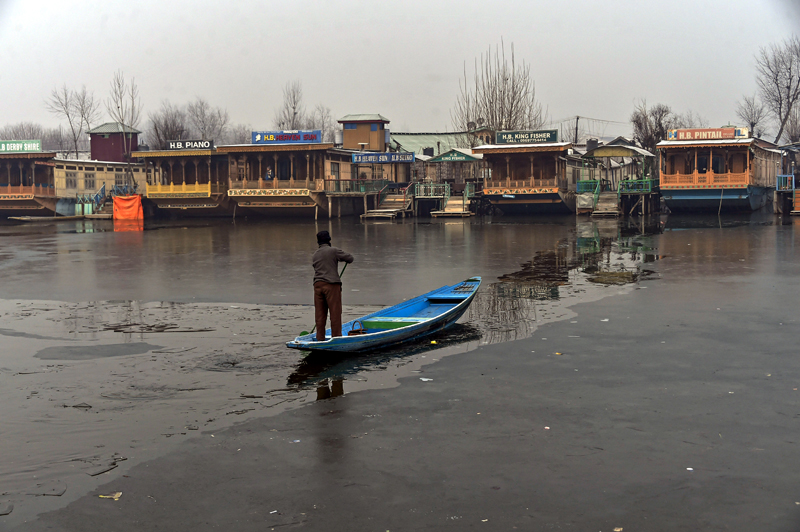
Fog hits 11 flights,10 trains; dry spell to continue in Kmr
*Winter capital turns 5 degrees colder than Srinagar
Gopal Sharma/Fayaz Bukhari
JAMMU/ SRINAGAR, Jan 10: The winter capital, Jammu recorded the coldest day of the season today, with the maximum temperature plummeting 10 notches below normal to settle at 8 degrees Celsius, while dense fog affected 11 flights and 10 trains in the region.
Dense fog continued to hit air, train and vehicular traffic in Jammu region for the last over one week. The winter capital Jammu is reeling under the severe cold conditions with no respite visible ahead under current weather conditions. The City of Temples (Jammu), remained 5 degrees colder than summer capital Srinagar today. The Sun was visible hardly for an hour or two during the day today.

Chief Scientist, Agrometeorology Deptt of SKUAST- Jammu, Dr Mahender Singh said that Chatha weather observatory of Jammu today recorded a maximum temperature of 8 degrees Celsius, which is about 10 degrees below normal. Singh said foggy and chilling-cold conditions will continue for the next couple of days in Jammu region.
Srinagar recorded a day temperature of 12.9 degrees Celsius on Wednesday, against previous day’s 14.2 degrees, which indicates that Jammu remained about five degrees colder than summer capital Srinagar.
The minimum temperature in the Temple City was recorded at 4.8 degrees Celsius, which was 2.6 degrees Celsius below normal for this part of the season while maximum 9 degrees, an official of the Indian Meteorological Department said.
The residents of Jammu plains and parts of Kathua and Samba belts are reeling under severe cold wave over the past one week with the mercury hovering several notches below normal due to foggy conditions in the morning hours and absence of the Sun during the day.
Banihal along the Jammu-Srinagar National Highway recorded a maximum of 18 degrees Celsius, which is 7.6 degrees Celsius above normal. However, the night temperature in the highway town was minus 1.4 degrees Celsius.
The holy township of Katra, the base camp for pilgrims visiting the Mata Vaishno Devi shrine, recorded a maximum of 16.2 degrees Celsius and a minimum of 5.7 degrees Celsius temperature, the official said.
Bhaderwah tourist resort in Doda district recorded a maximum temperature of 15.1 degrees Celsius and a low of minus 0.2 degrees while Batote town a maximum temperature of 15.6 degrees and minimum 2.2 degrees Celsius today.
A senior official at Jammu Airport said that 11 flights operated today at Satwari Airport, despite foggy weather conditions. He said till mid day the visibility was very poor over the airport and flight operation commenced after improvement in the weather. He said nine flights were delayed and rescheduled for the departure time.
Meanwhile, a Northern Railway spokesman said that 10 trains were delayed at Jammu station due to dense fog and poor visbility today. He disclosed that Puja Express arrived late by 17 hours, Durg Express 7 hours, Lohit Express 6 hours, Malwa Express late by 4 hours, Jhelum Express and Happa late by 3 hours, Utter Sampark Kranti by two hours while Sealdah and Hemkund Express arrived late by an hour today. The departure of Puja Express train at Jammu station was delayed by 10.45 hrs today.
Meanwhile, a dry spell prevailed in Kashmir valley even as the minimum temperature fell by several degrees, intensifying bone chilling conditions while days continue to be warmer with temperatures settling several notches above normal for this time of the year.
Director Meteorological Department in Srinagar, Mukhtar Ahmad told Excelsior that weather will remain dry till January 20. However, there will be feeble western disturbance on January 12 and 17 that might bring some snowfall in higher reaches of Kashmir. “There is no major weather disturbance this month,” he said.
Srinagar city recorded a minimum temperature of minus 5 degrees Celsius last night, down from minus 2.4 degrees Celsius recorded on the previous night.
Qazigund recorded a maximum of 13.4 degree Celsius which is 7.4 degree Celsius above normal for the place during this time of the year.
Pahalgam recorded a maximum of 10.2 degree Celsius which is 6.3 degree Celsius above normal for the place during this time of the year.
Kupwara recorded a maximum of 12.7 degree Celsius which is 6.6 degree Celsius above normal for the place during this time of the year.
Kokernag recorded a maximum of 11.6 degree Celsius which is 7.2 degree Celsius above normal for the place during this time of the year. Gulmarg recorded a maximum of 7.2 degree Celsius which is 6.7 degree Celsius above normal for the place during this time of the year.
The dry weather has resulted in freezing nights and warmer than usual days as Srinagar today recorded a maximum temperature of 12.9 degrees Celsius which was 6.8 degrees higher than usual for this time of the year.
Qazigund recorded a low of minus 4.4 degrees against minus 2.6 degrees Celsius, while in the ski resort of Gulmarg in north Kashmir it was minus 5 degrees Celsius on last night, slightly down from the minimum temperature recorded the previous night.
Pahalgam recorded a minimum temperature of minus 6.3 degrees Celsius, up from the previous night’s minus 4.4 degrees Celsius.
The minimum temperature in Kokernag town settled at minus 2.4 degrees Celsius and in Kupwara at minus 4.7 degrees Celsius.
Kashmir is currently under the grip of “Chilla-i-Kalan”, a 40-day harsh winter period, when a cold wave sweeps the region and temperatures drop considerably leading to the freezing of water bodies as well as water in pipes.
The chances of snowfall are the highest during this period and most areas, particularly the higher reaches, receive heavy snowfall.



